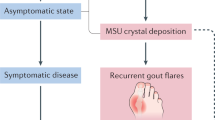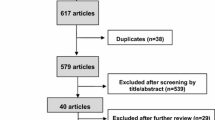Abstract
This systematic review aims to summarise published evidence that assessed the management of gout in regard to the following: prescription of urate lowering therapy (ULT), monitoring of serum urate levels (sUA) and allopurinol dosing in patients with renal impairment, lifestyle advice and acute management of gout. Studies investigating the management of gout in general practice (GP) were identified by searching PubMed and Scopus databases. To be eligible for inclusion, studies had to be focused on the GP setting alone. Studies were also excluded if they examined diagnosis without exploring management of gout. Editorials and reviews were excluded. A total of nine studies were identified. Eight studies explored the proportion of gout patients currently on ULT. Six out of the eight studies revealed that ULT was prescribed in less than 50 % of gout patients. Four studies considered the monitoring of sUA levels in gout patients. The results were generally similar throughout studies indicating sub-optimal management. Only two studies examined the monitoring of sUA levels specifically in patients who were prescribed ULT. The two studies showed 28 and 38 % of patients on ULT had their sUA levels monitored. Two studies examined the dosing of allopurinol in renally impaired patients and revealed that 74–78 % of renally impaired patients had an appropriate allopurinol dose of less than 300 mg. This systematic review suggests that gout is sub-optimally managed in general practice. However, more studies with a larger sample size focusing on active patients are required to provide more definitive evidence.

Similar content being viewed by others
References
Arromdee E, Michet CJ, Crowson CS, O'Fallon WM, Gabriel SE (2002) Epidemiology of gout: is the incidence rising? The J Rheumatol 29(11):2403–2406
Klemp P, Stansfield SA, Castle B, Robertson MC (1997) Gout is on the increase in New Zealand. Ann Rheum Dis 56(1):22–26
Owens D, Whelan B, McCarthy G (2008) A survey of the management of gout in primary care. Ir Med J 101(5):147–149
Terkeltaub R (2010) Update on gout: new therapeutic strategies and options. Nat Rev Rheumatol 6(1):30–38
Gout. Therapeutic Guidelines. 2010
Zhang W, Doherty M, Bardin T, Pascual E, Barskova V, Conaghan P et al (2006) EULAR evidence based recommendations for gout. Part II: management. Report of a task force of the EULAR standing committee for international clinical studies including therapeutics (ESCISIT). Ann Rheum Dis 65(10):1312–1324
Smith P, Karlson N, Nair BR (2000) Quality use of allopurinol in the elderly. J Qual Clin Pract 20(1):42–43
McClintock AD, Egan AJ, Woods DJ, Pillans PI (1995) A survey of allopurinol dosage prescribing. The NZ Medical J 108(1006):346–347
Neogi T, Hunter DJ, Chaisson CE, Allensworth-Davies D, Zhang Y (2006) Frequency and predictors of inappropriate management of recurrent gout attacks in a longitudinal study. The J Rheumatol 33(1):104–109
Moher D, Liberati A, Tetzlaff J, Altman DG, Group P (2010) Preferred reporting items for systematic reviews and meta-analyses: the PRISMA statement. Int J Surg 8(5):336–341
Harrold LR, Mazor KM, Velten S, Ockene IS, Yood RA (2010) Patients and providers view gout differently: a qualitative study. Chronic Illness 6(4):263–271
M; T, k M (2013) Gouty arthritis: an approach for general practice. South African Family Practice;55 (4)
Pascual E, Sivera F (2007) Why is gout so poorly managed? Ann Rheum Dis 66(10):1269–1270
Perry ME, Madhok R (2010) Treatment failure gout: failure to treat? Rheumatology 49(12):2233–2234
Shulten P, Thomas J, Miller M, Smith M, Ahern M (2009) The role of diet in the management of gout: a comparison of knowledge and attitudes to current evidence. J Human Nutr and Diet : The Off J The Br Diet Asso 22(1):3–11
Fara N, Vazquez Mellado J, Sequeira G, Kerzberg E (2012) A survey on the current evaluation and treatment of gout in Buenos Aires. Argent Reumatol Clin 8(6):306–309
Fraser RC, Davis RH, Walker FS (1987) Comparative trial of azapropazone and indomethacin plus allopurinol in acute gout and hyperuricaemia. The J The R Coll Gen Pract 37(302):409–411
Hanly JG, Skedgel C, Sketris I, Cooke C, Linehan T, Thompson K et al (2009) Gout in the elderly—a population health study. The J Rheumatol 36(4):822–830
Harrold LR, Mazor KM, Peterson D, Naz N, Firneno C, Yood RA (2012) Patients’ knowledge and beliefs concerning gout and its treatment: a population based study. BMC Musculoskelet Disord 13:180
Medellin MV, Erickson AR, Enzenauer RJ (1997) Variability of treatment for gouty arthritis between rheumatologists and primary care physicians. J Clin Rheumatol: Pract Rep on Rheum & Musculoskelet Dis 3(1):24–27
Goldfien RD, Ng MS, Yip G, Hwe A, Jacobson A, Pressman A et al (2014) Effectiveness of a pharmacist-based gout care management programme in a large integrated health plan: results from a pilot study. BMJ Open 4(1):e003627
Cea Soriano L, Rothenbacher D, Choi HK, Garcia Rodriguez LA (2011) Contemporary epidemiology of gout in the UK general population. Arthritis Res & Ther 13(2):R39
Harrold LR, Andrade SE, Briesacher B, Raebel MA, Fouayzi H, Yood RA et al (2010) The dynamics of chronic gout treatment: medication gaps and return to therapy. The Am J Med 123(1):54–59
Harrold LR, Andrade SE, Briesacher BA, Raebel MA, Fouayzi H, Yood RA et al (2009) Adherence with urate-lowering therapies for the treatment of gout. Arthritis Res & Ther 11(2):R46
Luk AJ, Simkin PA (2005) Epidemiology of hyperuricemia and gout. The Am J Manag Care 11(15):435–442, quiz S65-8
Annemans L, Spaepen E, Gaskin M, Bonnemaire M, Malier V, Gilbert T et al (2008) Gout in the UK and Germany: prevalence, comorbidities and management in general practice 2000–2005. Ann Rheum Dis 67(7):960–966
Cottrell E, Crabtree V, Edwards JJ, Roddy E (2013) Improvement in the management of gout is vital and overdue: an audit from a UK primary care medical practice. BMC Fam Pract 14:170
Harrold LR, Yood RA, Mikuls TR, Andrade SE, Davis J, Fuller J et al (2006) Sex differences in gout epidemiology: evaluation and treatment. Ann Rheum Dis 65(10):1368–1372
Kuo CF, Grainge MJ, Mallen C, Zhang W, Doherty M (2014) Rising burden of gout in the UK but continuing suboptimal management: a nationwide population study. Annals of the rheumatic diseases
Mikuls TR, Farrar JT, Bilker WB, Fernandes S, Saag KG (2005) Suboptimal physician adherence to quality indicators for the management of gout and asymptomatic hyperuricaemia: results from the UK general practice research database (GPRD). Rheumatology 44(8):1038–1042
Mikuls TR, Farrar JT, Bilker WB, Fernandes S, Schumacher HR Jr, Saag KG (2005) Gout epidemiology: results from the UK general practice research database, 1990–1999. Ann Rheum Dis 64(2):267–272
Roddy E, Mallen CD, Hider SL, Jordan KP (2010) Prescription and comorbidity screening following consultation for acute gout in primary care. Rheumatology 49(1):105–111
Singh JA, Hodges JS, Toscano JP, Asch SM (2007) Quality of care for gout in the US needs improvement. Arthritis Rheum 57(5):822–829
Roddy E, Zhang W, Doherty M (2007) Concordance of the management of chronic gout in a UK primary-care population with the EULAR gout recommendations. Ann Rheum Dis 66(10):1311–1315
Perry J (1971) Oxmis problem code for primary care. Oxmis Publications, Oxford
Acknowledgments
The work was funded by the James Cook University Honours fund.
Conflict of interest
None.
Author information
Authors and Affiliations
Corresponding author
Rights and permissions
About this article
Cite this article
Jeyaruban, A., Larkins, S. & Soden, M. Management of gout in general practice—a systematic review. Clin Rheumatol 34, 9–16 (2015). https://doi.org/10.1007/s10067-014-2783-z
Received:
Accepted:
Published:
Issue Date:
DOI: https://doi.org/10.1007/s10067-014-2783-z




